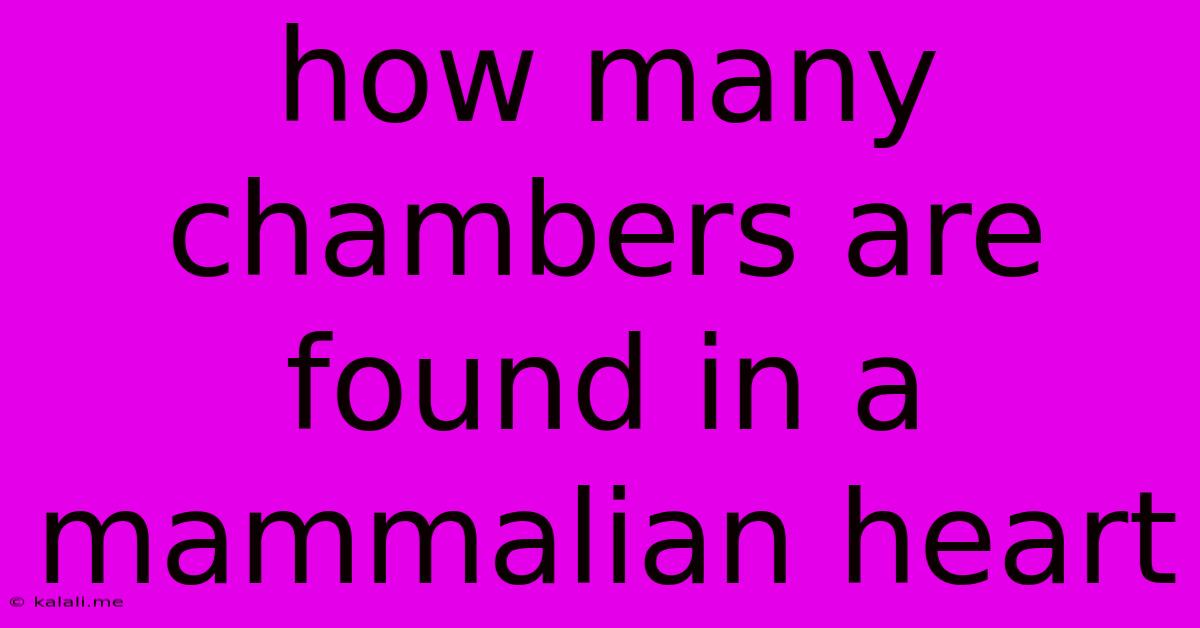How Many Chambers Are Found In A Mammalian Heart
Kalali
Jun 16, 2025 · 3 min read

Table of Contents
How Many Chambers Are Found in a Mammalian Heart? A Deep Dive into Cardiac Anatomy
The mammalian heart, a remarkable organ responsible for tirelessly pumping blood throughout the body, is a marvel of biological engineering. One of the fundamental aspects of its structure is the number of chambers it possesses. Understanding this is crucial to grasping the intricacies of blood circulation and overall cardiovascular health. This article will delve into the precise number of chambers, their individual functions, and the significance of this four-chambered design in mammals.
The Four Chambers: A Symphony of Circulation
The definitive answer is: a mammalian heart has four chambers. These chambers work in a coordinated sequence to ensure efficient oxygenation of blood and its subsequent delivery to the body's tissues. The four chambers are:
- Right Atrium: This chamber receives deoxygenated blood returning from the body through the superior and inferior vena cava.
- Right Ventricle: The right atrium pumps blood into the right ventricle, which then pumps it to the lungs via the pulmonary artery. This is where the blood picks up oxygen.
- Left Atrium: Oxygenated blood from the lungs returns to the heart through the pulmonary veins, entering the left atrium.
- Left Ventricle: The left atrium pumps blood into the left ventricle, the strongest chamber of the heart. The left ventricle then pumps the oxygen-rich blood out to the body via the aorta, the body's largest artery.
Why Four Chambers? The Evolutionary Advantage
The four-chambered heart is a significant evolutionary advancement. Compared to the simpler two-chambered hearts found in some fish, or the three-chambered hearts of amphibians and reptiles, the mammalian four-chambered design offers several crucial benefits:
-
Complete Separation of Oxygenated and Deoxygenated Blood: This is perhaps the most critical advantage. The complete separation prevents the mixing of oxygen-rich and oxygen-poor blood, ensuring highly efficient oxygen delivery to the body's tissues. This is vital for maintaining high metabolic rates characteristic of mammals.
-
Higher Blood Pressure: The separation and efficient pumping action of the four chambers allow for the maintenance of higher blood pressure. This facilitates more effective circulation and delivery of nutrients and oxygen to all parts of the body.
-
Enhanced Metabolic Efficiency: The efficient oxygen delivery directly supports the higher metabolic rates found in mammals, enabling their active lifestyles and complex biological functions.
-
Improved Thermoregulation: Efficient circulation is crucial for maintaining a constant body temperature – a hallmark of mammalian endothermy.
Variations and Considerations
While the four-chambered heart is the standard for mammals, subtle variations can exist depending on the species. However, the fundamental structure and function remain consistent across the mammalian class. Understanding these variations requires a deeper dive into comparative vertebrate anatomy.
Conclusion: A Powerful and Efficient Design
The four chambers of the mammalian heart represent a pinnacle of evolutionary design. This sophisticated structure ensures the efficient transport of oxygen and nutrients throughout the body, supporting the high metabolic activity and complex biological functions that characterize mammals. Understanding the anatomy and physiology of the four-chambered heart is fundamental to comprehending the overall health and well-being of mammals, including humans.
Latest Posts
Latest Posts
-
What Is The Function Of Washer
Jun 16, 2025
-
10 Differences Between Prose And Poetry
Jun 16, 2025
-
Is Soil A Element Compound Or Mixture
Jun 16, 2025
-
Which Of The Following Solutions Is The Most Acidic
Jun 16, 2025
-
What Is A Factor Of 86
Jun 16, 2025
Related Post
Thank you for visiting our website which covers about How Many Chambers Are Found In A Mammalian Heart . We hope the information provided has been useful to you. Feel free to contact us if you have any questions or need further assistance. See you next time and don't miss to bookmark.